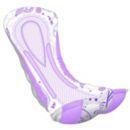Urinary incontinence can be frustrating, but with this simple guide, you can regain the confidence and life you once had:
- Don’t: Use regular soap and water for incontinence cleaning.
Why: This can cause dryness and irritation for those with fragile skin. - Don’t: Wear an incontinence product that is too large or too small.
Why: This can also lead to skin infections or diaper leakage. - Don’t: Restrict fluids to treat incontinence.
Why: A lack of fluids can lead to dehydration, which can cause constipation and worsen your incontinence symptoms. - Don’t: Use menstrual pads to protect against light bladder leakage.
Why: Sanitary napkins are meant to absorb menstrual flow, not the rapid dispersion and acidity of urine. - Don’t: Stay in a soiled incontinence product.
Why: Long exposure to urine and fecal matter can lead to skin breakdown and painful pressure sores.
Do: Use disposable washcloths and rinse-free cleansers to prevent adult diaper rashes.
Do: Measure the waist, hips, and thighs, and take note that different brands have different sizing charts before selecting an incontinence product.

Do: Carry a water bottle to stay hydrated throughout the day.
Do: Wear incontinence pads or male guards that are specially designed for light urinary incontinence.
Do: Change as soon as soiling occurs. If this is unavoidable, wear a more absorbent undergarment with moisture-wicking capabilities.
